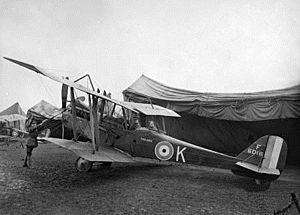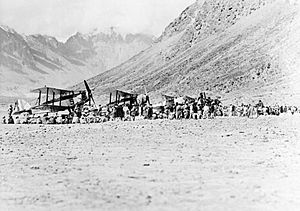No. 5 Squadron RAF facts for kids
Quick facts for kids No. V (AC) Squadron RAF |
|
|---|---|
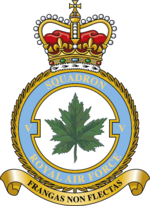
Squadron badge
|
|
| Active | 26 July 1913 – 1 April 1918 (RFC) 1 April 1918 – 20 January 1920 (RAF) 1 April 1920 – 1 August 1947 11 February 1949 – 25 September 1951 1 March 1952 – 12 October 1957 20 January 1959 – 7 October 1965 8 October 1965 – 30 September 2002 1 April 2004 – 31 March 2021 |
| Country | |
| Branch | |
| Type | Flying squadron |
| Motto(s) | Frangas non flectas (Latin for 'Thou mayst break, but shall not bend me') |
| Battle honours |
|
| Insignia | |
| Squadron badge heraldry | A maple leaf, commemorating the squadron's close links with the Canadian Corps during the First World War. Approved by King George VI in June 1937. |
| Squadron roundel | |
| Squadron codes | QN (Apr 1939 – allocated but possibly not used) OQ (Sep 1939 – Feb 1941, Mar 1946 – Aug 1947) B (Mar 1952 – 1955) A (Aug 1986 – Dec 1987) CA–CZ (Tornado F.3) |
No. V (Army Co-operation) Squadron was a special flying unit of the Royal Air Force (RAF). It was known for its long history and important roles. Most recently, it flew Raytheon Sentinel R1 aircraft from RAF Waddington in Lincolnshire, England. These planes were used for advanced radar sensing from April 2004 until March 2021.
The squadron first started in July 1913. It played a big part in the First World War, being the first unit of the Royal Flying Corps to have an aircraft shot down and also to shoot down an enemy plane. After the war, No. V Squadron moved to India in 1920. It stayed there through the Second World War. During the Cold War, the squadron flew powerful fighter jets like the English Electric Lightning and the Panavia Tornado F3.
Contents
History of No. V Squadron
Early Days and the First World War
No. 5 Squadron of the Royal Flying Corps (RFC) was created on 26 July 1913. It was formed at Farnborough, Hampshire, using members from No. 3 Squadron. When the First World War began, No. V Squadron quickly moved to France on 15 August 1914. They used various aircraft to perform reconnaissance (scouting missions) for the British Expeditionary Force (BEF).
Their first missions were flown on 21 August. The very next day, an Avro 504 from No. 5 Squadron became the first British aircraft to be shot down. Its crew, pilot Vincent Waterfall and navigator Charles George Gordon Bayly, were sadly killed over Belgium. Just two days later, on 24 August, No. V Squadron made history again. They became the first RFC unit to shoot down an enemy aircraft using gunfire. This happened when Lt. Wilson and Lt. Rabagliati shot down a German Etrich Taube plane.
The squadron mainly used the Royal Aircraft Factory B.E.2 aircraft. They became experts at observing for artillery (large guns). In May 1917, they switched to the Royal Aircraft Factory R.E.8. They worked closely with the Canadian Corps until the end of the war. This strong connection with the Canadian Corps is why a maple leaf was later added to the squadron's badge in 1937.
Between the World Wars
No. V Squadron returned to the UK in September 1919 and was temporarily closed down on 20 January 1920. However, it was reformed in Quetta, India (which is now part of Pakistan), on 1 April 1920. This happened when No. 48 Squadron was given the new number. In India, the squadron continued its work, helping the army with air support during operations on the North West Frontier. When it reformed, the unit flew Bristol F.2B aircraft until 1931. In May 1931, No. 5 Squadron started using the Westland Wapiti Mk.IIa instead.
Second World War Service
When the Second World War began in September 1939, No. 5 Squadron was based at Fort Sandeman in India. They were still flying the older Westland Wapiti biplane. The squadron changed its role to a light bomber unit in June 1940, when they started flying the Hawker Hart. In February 1941, No. 5 Squadron switched to the Hawker Audax and used it as a fighter plane.
In December 1941, the squadron moved to RAF Dum Dum in Calcutta. Here, they received their first modern monoplane, the American-built Curtiss Mohawk Mk.IV. In May 1942, No. V Squadron moved to RAF Dinjan in Assam. Their job was to escort Bristol Blenheim bombers over north-west Burma.
The Mohawks were replaced by Hawker Hurricane Mk.IIcs and Mk.IIds in June 1943. At this time, the squadron was based at RAF Kharagpur. In September 1944, No. 5 Squadron changed aircraft again, this time to the Republic Thunderbolt Mk.I and Mk.II. In May 1945, No. V Squadron was pulled back from the front lines. They were getting ready to help free Malaya from Japanese occupation. However, this mission was never needed because the Japanese Empire surrendered on 15 August 1945.
The Cold War Era
No. 5 Squadron remained in India and started flying Hawker Tempest F.2 aircraft in February 1946. But the squadron was closed down on 1 August 1947 because of the Partition of India. On 11 February 1949, the squadron was reformed at RAF Pembrey in Wales. Their new job was target-towing, which meant pulling targets for other planes to practice shooting at. This happened when No. 595 Squadron was given the No. 5 number. However, this lasted only a short time, and the squadron was closed again on 25 September 1951.
The squadron reformed once more on 1 March 1952, at RAF Wunsdorf in West Germany. They were equipped with de Havilland Vampire F.5 jets. In December 1952, No. V Squadron switched to the de Havilland Venom FB.1. Due to changes in military plans, No. 5 Squadron was disbanded again on 12 October 1957 while flying the Venom FB.5.
On 20 January 1959, the squadron reformed as a night fighter unit at RAF Laarbruch, West Germany. They flew Gloster Meteor NF.11 jets. In January 1960, No. 5 Squadron began to convert to the Gloster Javelin FAW.5, a jet with delta-shaped wings. When No. 33 Squadron was closed on 17 December 1962, No. V Squadron received their Javelin FAW.9 jets and some of their crew. No. 5 Squadron itself was disbanded on 7 October 1965 at RAF Geilenkirchen.
Lightning and Tornado Jets (1965–2003)
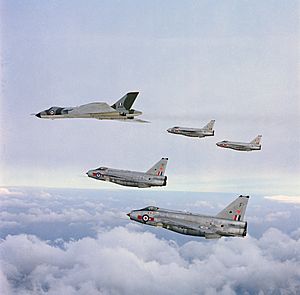
The squadron reformed as No V (AC) Squadron at RAF Binbrook, Lincolnshire, on 8 October 1965. They were to fly the English Electric Lightning interceptor jet. Their first Lightning jet arrived on 19 November. The squadron's first single-seat Lightnings arrived on 10 December 1965. No. V (AC) Squadron received their first production Lightning F.6 on 3 January 1967.
In November 1987, No. V (AC) Squadron flew nine Lightning F.6s together to mark the jet's upcoming retirement after 22 years of service. The last Lightnings were removed by December 1987. The squadron then moved to RAF Coningsby to get ready for the Panavia Tornado F.3 jet. No V (AC) Squadron received their first Tornado F.3 in January 1988.
In August 1990, V (AC) Squadron was one of the first RAF squadrons to be sent to the Gulf War. Six Tornado F.3s arrived in Saudi Arabia on 11 August. Between 1993 and 1995, the squadron helped enforce the no-fly zone over Bosnia and Herzegovina as part of Operation Deny Flight. No V (AC) Squadron was disbanded on 30 September 2002. Its personnel were moved to other units.
Sentinel R1 Operations (2004–2021)
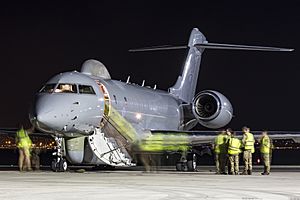
The squadron reformed on 1 April 2004 as No. 5 (Army Co-operation) Squadron at RAF Waddington. The first Raytheon Sentinel R1 aircraft made its first flight on 26 May 2004. This ASTOR system (Airborne STand-Off Radar) officially began service with No. 5 (AC) Squadron on 1 December 2008. The fifth and last Sentinel jet was delivered to the squadron in February 2009. By the end of 2010, the system was fully operational.
These new radar-equipped aircraft provided important battlefield and ground surveillance for the British Army. In 2011, Sentinels from No. V (AC) Squadron took part in operations over Libya as part of Operation Ellamy. These missions were later called very important by RAF Air Chief Marshal Sir Stephen Dalton.
Between 2009 and 2011, No. V (AC) Squadron also briefly flew four Hawker Beechcraft Shadow R.1 aircraft. These were based on the Beechcraft King Air 350. The first Shadow R.1 was delivered in May 2009. These planes were later transferred to the newly reformed No. 14 Squadron in October 2011.
On 25 January 2013, a Sentinel R1 was sent to Dakar-Ouakam Air Base in Senegal. It helped with France's Operation Serval in Mali. Over four months, the Sentinels flew for 697 hours across 66 missions. On 18 May 2014, the squadron sent a Sentinel to Kotoka International Airport in Ghana. This was to help search for 223 schoolgirls who had been kidnapped by Boko Haram in Nigeria.
In September 2014, the squadron temporarily moved to RAF Cranwell with No. 14 Squadron. This was because RAF Waddington's runway was being repaired, which took over a year. No. 5 (AC) Squadron sent a Sentinel R.1 to Exercise Red Flag 15–1 at Nellis AFB in Nevada. This happened between 26 January and 13 February 2015. On 26 March 2015, No. 5 (AC) Squadron sent two Sentinel R1s to RAF Akrotiri in Cyprus. They supported Operation Shader.
In July 2017, Sentinel R.1 ZJ693 was taken out of service. The remaining four Sentinels were planned to be retired by 2021. In February 2020, the Ministry of Defence confirmed the retirement date as March 2021. On 25 February 2021, ZJ694 flew No. V (AC) Squadron's last Sentinel R.1 operational mission. Over the Sentinel's 14 years of service, the squadron flew 32,000 hours across 4,870 missions. The squadron was then officially closed down on 31 March 2021.
Aircraft Flown by No. 5 Squadron
Aircraft operated by No. 5 Squadron include:
- Farman MF.7 Longhorn (July 1913–July 1914)
- Farman HF.20 (July 1913–July 1914)
- Farman MF.7 Longhorn (July 1913–Mar 1915)
- Royal Aircraft Factory S.E.2a (Jan 1914–Mar 1914)
- Sopwith Three-seater (Feb 1914–Aug 1914)
- Royal Aircraft Factory B.E.1 (1914–Aug 1914)
- Sopwith Tabloid (June 1914–Aug 1914)
- Avro 504 (July 1914–Aug 1915)
- Royal Aircraft Factory B.E.8 (Aug 1914–Sep 1914)
- Farman HF.27 (Sep 1914–Sep 1914)
- Bristol Scout (Sep 1914–Oct 1914; 1915–Mar 1915)
- Martinsyde S.1 (Jan 1915–Aug 1915)
- Voisin LA (Feb 1915–Mar 1915)
- Blériot Parasol (Mar 1915–May 1915)
- Vickers F.B.5 (Mar 1915–Jan 1916)
- Caudron G.3 (Apr 1915–May 1915)
- Airco DH.2 (July 1915–Aug 1915; Jan 1916–May 1916)
- Royal Aircraft Factory B.E.2c (Aug 1915–Apr 1917)
- Royal Aircraft Factory F.E.8 (Dec 1915–May 1916)
- Royal Aircraft Factory B.E.2d (June 1916–June 1917)
- Royal Aircraft Factory B.E.2e (Jan 1917–June 1917)
- Royal Aircraft Factory B.E.2f (Jan 1917–June 1917)
- Royal Aircraft Factory B.E.2g (Jan 1917–June 1917)
- Royal Aircraft Factory R.E.8 (May 1917–Mar 1918)
- Bristol F.2B (Mar 1919–Sep 1919; Apr 1920–May 1931)
- Westland Wapiti Mk.IIa (May 1931–June 1940)
- Hawker Hart (June 1940–Feb 1941)
- Hawker Audax (Feb 1941–Sep 1942)
- Curtiss Mohawk Mk.IV (Dec 1941–June 1943)
- Hawker Hurricane Mk.IIc (June 1943–Sep 1944)
- Hawker Hurricane Mk.IId (June 1943–Sep 1944)
- Republic Thunderbolt Mk.I (Sep 1944–Feb 1946)
- Republic Thunderbolt Mk.II (Sep 1944–Feb 1946)
- Hawker Tempest F.2 (Mar 1946–Aug 1947)
- Supermarine Spitfire LF.16e (Feb 1949–Feb 1951)
- Miles Martinet TT.1 (Feb 1949–Feb 1951)
- Airspeed Oxford T.1 (Feb 1949–Feb 1951)
- Bristol Beaufighter TT.10 (Feb 1949–Feb 1951)
- de Havilland Vampire F.3 (Aug 1950–Sep 1951)
- de Havilland Vampire FB.5 (Mar 1952–Dec 1952)
- de Havilland Venom FB.1 (Dec 1952–July 1955)
- de Havilland Venom FB.4 (July 1955–Oct 1957)
- Gloster Meteor NF.11 (Jan 1959–Aug 1960)
- Gloster Javelin FAW.5 (Jan 1960–Nov 1962)
- Gloster Javelin FAW.9 (Nov 1962–Oct 1965)
- Hawker Hunter T.7A (Oct 1965–196?)
- English Electric Lightning T.5 (Nov 1965–1987)
- English Electric Lightning F.3 (Dec 1965–Jan 1967; Oct 1972–Sep 1987)
- English Electric Lightning F.6 (Dec 1966–Dec 1987)
- English Electric Lightning F.1A (June 1970–Sep 1972)
- Panavia Tornado F3 (Jan 1988–Sep 2002)
- Raytheon Sentinel R1 (2006–March 2021)
- Hawker Beechcraft Shadow R1 (May 2009–Oct 2011)
See also
- List of Royal Air Force aircraft squadrons


